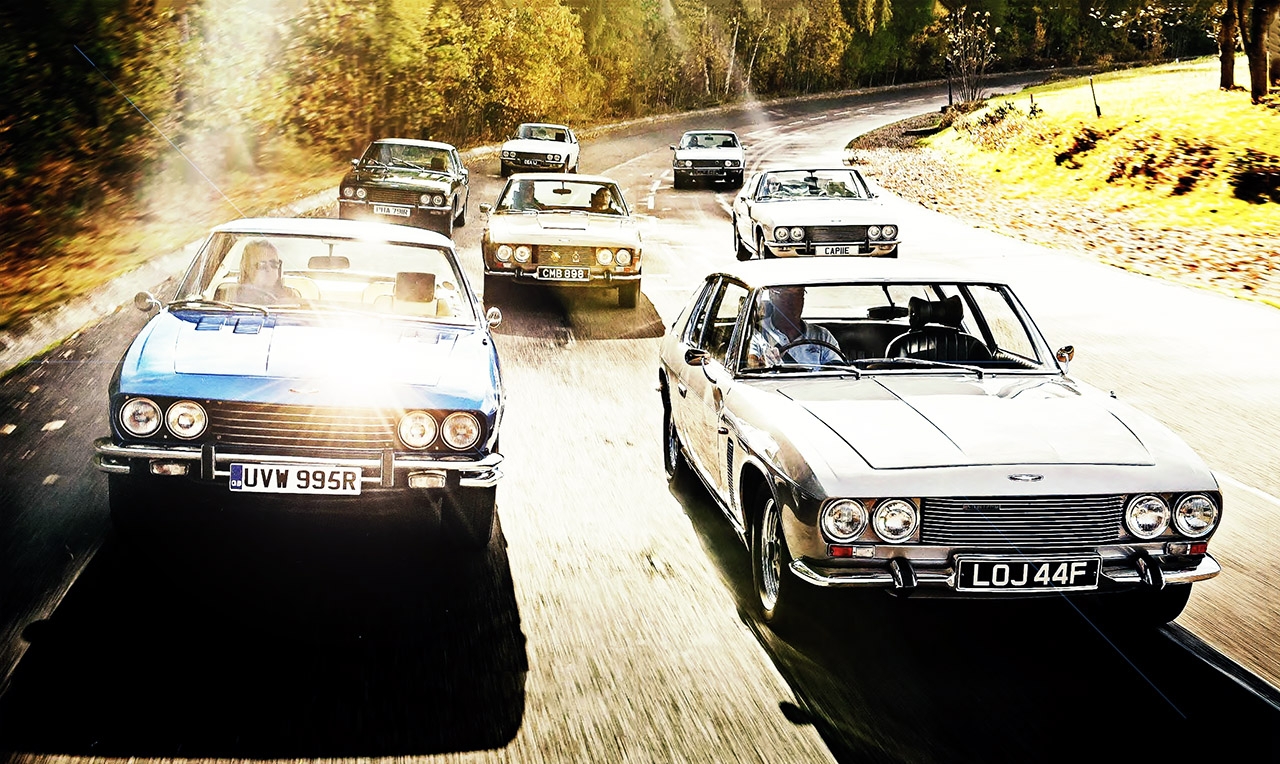
Intercept this Jensen Interceptor at 50. Words Andrew Noakes. Photography Laurens Parsons. 50 years ago Jensen Cars launched a GT car fit for a rock star. We drive it fast and loud for a day to celebrate.
‘Being surrounded by all this beauty and power is almost overwhelming’
Get ready to rumble – we celebrate 50 years of the Interceptor with a very special family reunion.
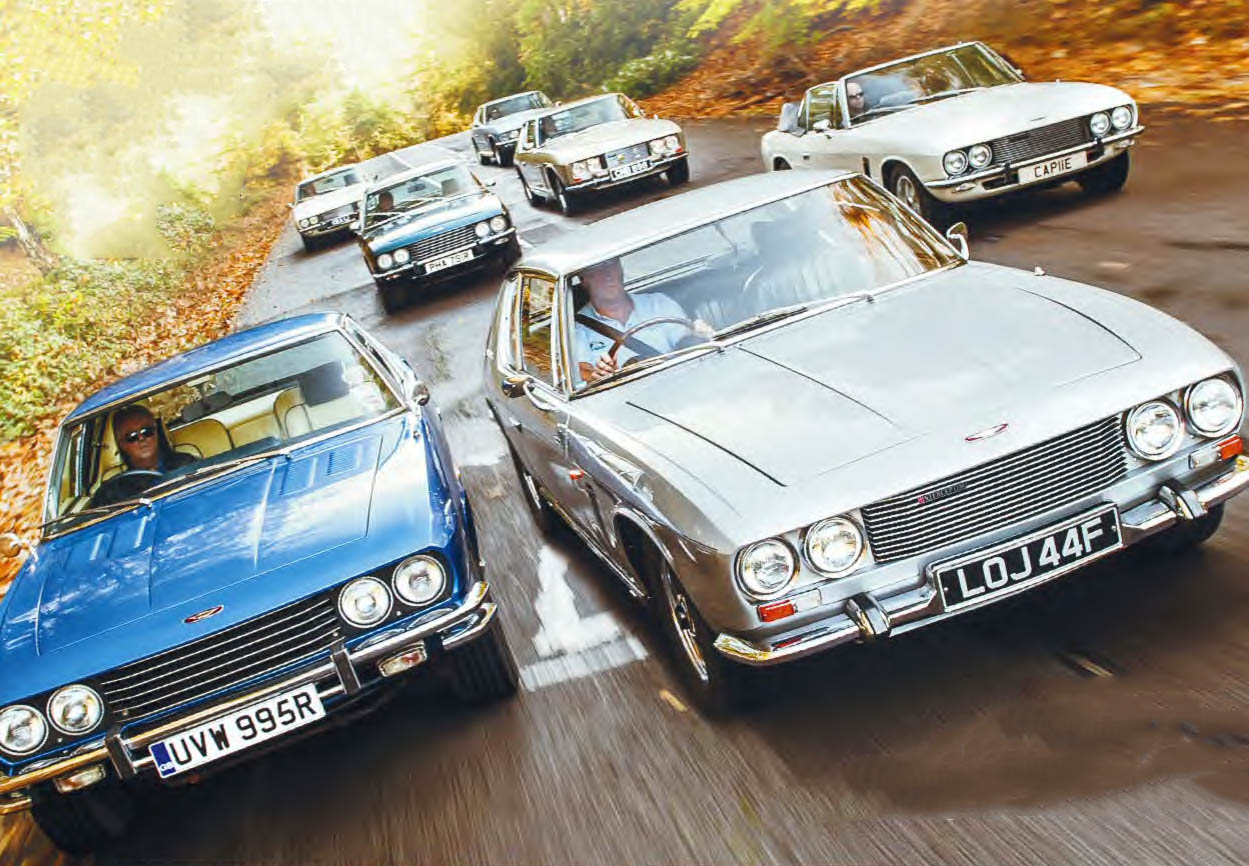
The Big Test At a stroke Jensen created a design icon with the Interceptor. We celebrate its half-century with a 48-litre test of key models, from the first GT to the final Coupé. Here come the Interceptors! From front: Interceptor I, Coupé (Jensen -built), FF, Convertible, Coupé (Panther), III, II.
‘Give the accelerator a good shove and there’s a moment’s hesitation before the V8’s torque hauls it down the road to a roaring soundtrack’
Unassisted steering is a joy at speed but a nightmare when parking. PAS was standard on Interceptor II.
Interceptor’s 6.2-litre V8 had Carter AFB (aluminium four barrel) carburettors to 1967, AVS (air valve secondary) to 1969.
Elegant wood-rimmed steering wheel was fitted to the earliest Vignale-built cars.
Exquisite detailing typified by aircraft-style switchgear.
NIGEL McMORRIN 1967 INTERCEPTOR
‘I’ve had my early Interceptor for over 10 years now. I didn’t actually set out to buy one, I just decided one day that I was going to buy a classic car, and it had to be something interesting and British.
‘I went to Wales to see this car, and bought it pretty much on the spot. It was the only one I’d ever driven, and I was instantly smitten. ‘It didn’t all go to plan. I had to have the engine completely rebuilt when I discovered that the valves had stuck because the car had sat unused for 12 years. I really didn’t know my stuff back then – and got my fingers burned. I wouldn’t have bought it if I’d known the engine wasn’t right, but I soon got over it and the car’s great now.
‘Being an early car, it’s rather basic. I had power steering fitted. because the original set-up was hardwork – I avoided three-point turns at all costs.
‘It’s not quite as comfortable or good to drive as later cars, but I think it’s the best-looking.’
Get up close to a Jensen Interceptor. Walk around it. Drink in the myriad details of its shape. It’s difficult to believe that this car is 50 years old. The bluff front and chrome bumpers may distance it from modern machinery, but the basic design’s cohesion and clarity transcend its era and leave the Interceptor looking somehow timeless.
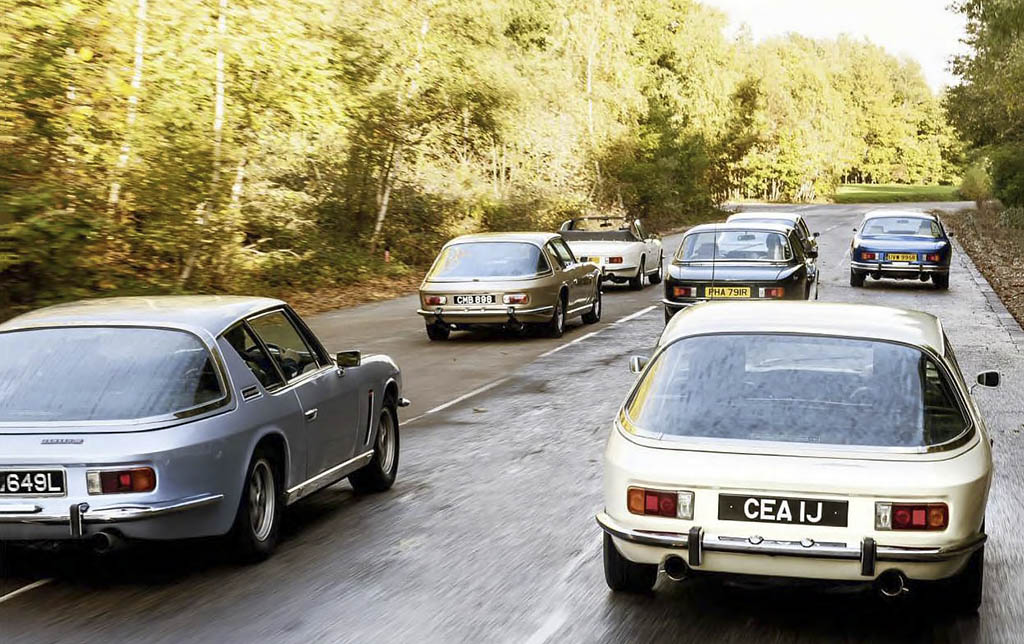
Yet for all is chiselled good looks, undoubted performance and robust engineering, the big GT from West Bromwich has never matched the values mustered by contemporary rivals from the likes of Aston Martin or Maserati. Is this a fair reflection of the Interceptor’s relative merits, or just evidence of a blinkered market looking down its nose at the off-the-shelf Chrysler engines? More to the point, how deep is its appeal half a century on? That’s what we’re here to find out. From the earliest cars with their distinctive wrap-around rear windows, through to the Convertible and almost unheard-of Coupés – not forgetting the ground-breaking Jensen FF – we’ve gathered together every Interceptor body style and all the major mechanical variants here – probably the first time they’ve all been tested together back-to-back. Excited? I certainly am.
INTERCEPTOR
It was Jensen engineer Kevin Beattie who hit upon the idea of using the CV8’s engine and running gear in an Italian-designed body to create a new model. Beattie convinced managing director Brian Owen and John Boex, then head of Jensen’s parent company Norcros, that Italian style was the way forward. The Jensen CV8’s body was glassfibre, like that of the preceding Jensen 541, and sat on a twin-tube steel chassis. But the Interceptor’s two large-diameter tubes formed part of a platform to which the Touring-designed steel body was welded. Vignale of Turin worked with Beattie to turn early designs into a fully engineered car in just nine months and actually built the first few bodies before shipping them to West Bromwich for final finishing and to have the running gear installed. The arrangement didn’t last long – Vignale’s bodies were expensive and lacked the quality Jensen demanded, so production soon moved in-house.

Sitting in the driver’s seat today, the Italian influence is easy to see. The large wood-rimmed steering wheel’s three tapered alloy spokes would look perfectly at home in a Sixties Maserati or Lamborghini and behind it the main instruments are housed in two separate black binnacles, with minor dials and switches grouped together in a central stack. Hidden in the middle, the tiny ignition key triggers a mighty-sounding starter motor that causes six-and-a-bit litres of Chrysler V8 to turn over and over. One or two cylinders catch, then the others join and build to a thundering V8 crescendo through the drainpipe-sized twin exhaust pipes.
I pull the automatic gearbox selector lever back into Drive and gently squeeze the long-travel accelerator and the Interceptor surges forwards with a muted burble that changes in timbre as the gearbox slips into intermediate then top.
Give the accelerator a good shove and there’s a moment’s hesitation before the transmission kicks down and the long bonnet rises. The Chrysler V8’s prodigious torque hauls the Interceptor down the road to a roaring soundtrack, the transmission, servoassisted brakes and prodigious engine feeling utterly unstressed. I suspect that the original unassisted steering would have let the side down but this example has been upgraded with power assistance.
Later steering and suspension parts are often fitted to early Interceptors so check specifications carefully if absolute originality is important. It makes sense to avoid cars needing work, because though the body and chassis are a strong, welded unit they’re not immune from rust and the complex structure means repairs are likely to be expensive. Replacing sills alone costs £2000 per side. Check the sills, doors, front and rear valances and front wings inside and out. Interiors stand up well to use, but a full retrim requires seven full hides, the bill for which is around £10,000.
The engine and transmission are robust and parts for both plentiful, but listen out for strange noises and look for evidence that high-quality belts and hoses have been fitted during routine maintenance, because cheaper alternatives are often troublesome in the hot underbonnet environment.
Jensen Owners’ Club chairman Paul Lewis says values are on the up. ‘Aston Martins have gone out of reach,’ he says, ‘so people are looking at Interceptors with new eyes.’ Good early cars start at around £25,000, with excellent cars going for £45,000 and concours winners fetching £75,000 or more.
FF
It’s hard to tell you’re sitting in an Jensen FF rather than an Interceptor from behind the wheel, though front seat passengers may well complain about their narrow, offset seat. It feels much the same as an Interceptor at low speeds, but the benefits of the four-wheel drive system soon become apparent when I pick the pace up a little. The Interceptor has high cornering limits – on smooth roads at least – but it squats on its rear axle under power and the immense torque always feels like it’s about to overwhelm the rear tyres.

In contrast the FF feels much more secure when you floor it. Period road testers discovered that it drifts all four wheels beyond the limit and keeps its composure even if you jab the brake pedal mid-corner. The way it drives today is frankly remarkable given its age, so it must have been a revelation when it was launched. FFs were popular with rock drummers in period, including The Jimi Hendrix Experience’s Mitch Mitchell – who had a metallic purple one – and Cream’s Ginger Baker, who had several.
And you certainly needed a rock star’s income to buy one back then; in 1966 it cost £5340, some 40 per cent more than an Interceptor and £250 more than an Aston Martin DB6. Little wonder that only 320 were built before production ended in 1971. Jensen and Vignale developed the Interceptor in double-quick time, which is all the more remarkable when you consider they were working on another car at the same time. It’s easy to view the FF, which was launched at the 1966 London Motor Show alongside the Interceptor, as nothing more than a four-wheel-drive Interceptor, but the differences between the two run much deeper than that.
The Ferguson Formula four-wheel drive and Dunlop Maxaret anti-lock braking systems were developed for a CV8-based FF prototype that appeared at the Earls Court show in 1965. It shares the Interceptor’s Chrysler Hemi engine and Torqueflite transmission, but a centre differential behind the gearbox splits the power between the axles. A Morse Hy-Vo chain drives the front propshaft, which passes to the left of the gearbox and sump.
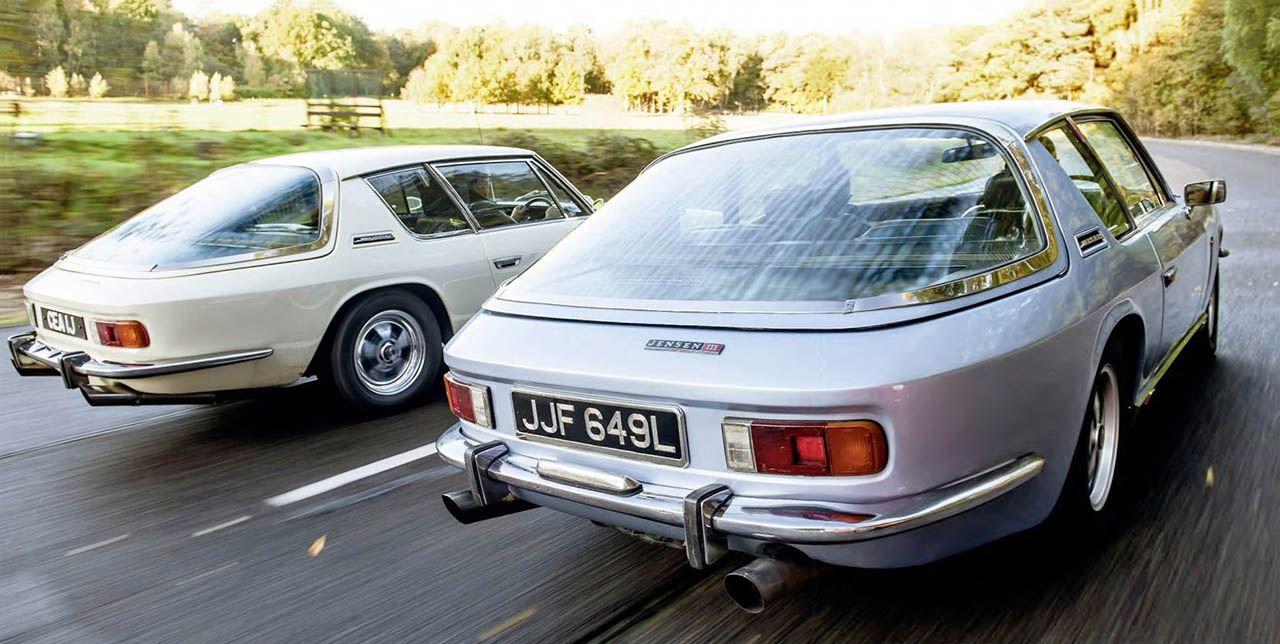
The engine is offset to the right to accommodate it, which in turn necessitated a redesigned front chassis. The wheelbase is also four inches longer to create space ahead of the engine for the front axle. Inside, a bulge on the left of the transmission tunnel clears the centre differential but encroaches on front passenger space and necessitates a narrower seat. Reprofiled front wings – inset with additional air vents to help disguise the longer wheelbase – mean the FF is an inch wider than the Interceptor and a chrome-trimmed bonnet vent completes the picture.
FF values today are higher than those of the Interceptor, with even rough examples selling for around £25,000. Good ones go for closer to £80,000 and the very best can command £140,000 or more. Weak spots largely mirror the Interceptor, so body and sill corrosion are the biggest enemies and cracks at the corners of the bonnet vent are common. The four-wheel drive system that contributes so much to the FF’s extraordinary character, on the other hand, rarely gives trouble.
INTERCEPTOR II AND INTERCEPTOR III
The 1969-on Interceptor II introduced a wealth of detail improvements but standard power-assisted steering was the most significant. The smaller leather-bound wheel turns with very little effort but the new ball-jointed front suspension and telescopic dampers still constantly feed back to the driver what the front wheels are doing; for all of its bulk, the Interceptor II is extremely easy to place on the road. Contemporary road tests suggested that the heavier Interceptor II was fractionally slower than the earlier cars, but in reality there’s very little in it – it performs very much like the original, even if its handling is slightly sharper.
From the outside the most obvious change is the higher front bumper with the sidelight/indicator unit mounted below it rather than above. Inside, the Interceptor II’s more modern moulded plastic dashboard was designed to meet new US safety regulations and the ignition switch moved to the steering column. The seats are more comfortable, the steering wheel leather-rimmed and the improved ventilation system boosted by optional air conditioning.
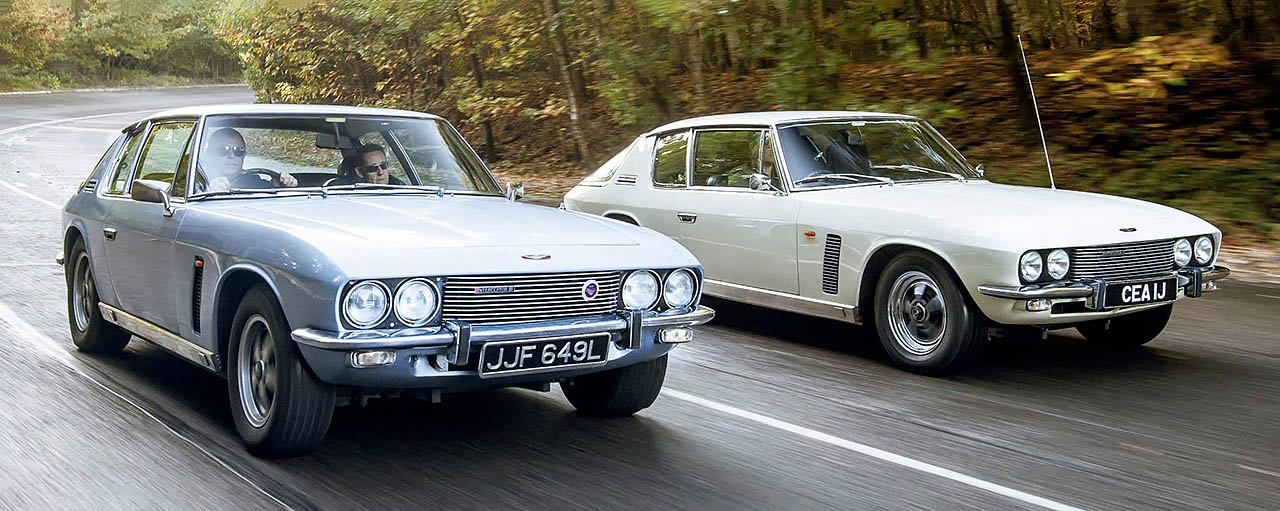
This Interceptor III is an altogether different animal – in fact it’s probably the quickest car here. And yet the first cars introduced in October 1971 had 6.3-litre engines strangled by anti-smog equipment. And while later models gained a low-compression version of the even larger 7.2-litre Chrysler 440 V8, it was good for only 280bhp – much the same as the first-generation Interceptor. Between June and December 1972 however, Jensen fitted a highcompression version of the bigger engine packing a full 305bhp.
This particular Interceptor III might even have more than that thanks to a free-flow exhaust system that makes its aural presence felt the moment I turn the key.
It seethes with intent even at idle. Mash the accelerator pedal into the Wilton deep-pile carpets and the exhaust note instantly takes on a deeper, more guttural growl. The extra power more than offsets the extra weight and the engine responds with a level of crispness that the low-compression V8s just can’t match.
The Interceptor III handles more fluidly than the earlier cars, too. There’s still a big leaf-sprung live axle at the back, but it’s less prone to getting thrown off balance by mid-corner bumps.
And this Interceptor really comes together in high compression form, matching the refinement that was always there from the outset with genuine pace and handling panache.
It’s easy to see why the Interceptor was such a favourite with celebrities and captains of industry, and remained so well into the Seventies. Customers were a diverse bunch, including sports stars Henry Cooper, Jack Nicklaus and Sir Matt Busby, musicians Dusty Springfield and John Bonham, entertainers Eric Morecambe and Mike Yarwood, novelist Harold Robbins and even Conservative politician Lord Carrington. ‘Interceptors were major contenders,’ says Jensen Owners Club chairman Paul Lewis. ‘They had some serious backsides on the leather when they were new.’

Four decades on, the good news for buyers is that these later Interceptors are better protected against rust than the early cars, though the more complex emission-controlled engine can sometimes be troublesome. Prices are broadly in line with earlier cars – you might find a basket case in need of a lot of expensive restoration work for £7500, but solid if tatty examples are double that. Good cars sell for around £25,000 and the best make £75,000 or more.
INTERCEPTORI II CONVERTIBLE
Car makers worldwide had pretty much given up on convertibles in the late Sixties when impending US safety legislation was expected to outlaw them. So Jensen pounced when the draconian rules failed to make it on to the statute books and launched an Interceptor Convertible in 1974 to plug an obvious gap in the market.
The Interceptor’s steel roof and distinctive curved rear window were replaced by a new bootlid and an electrically operated multilayer folding roof which dropped down on to a tray behind the rear seat. Unfortunately, rather than folding flush with the surrounding bodywork, the hood stacked up pram-style behind the rear seat with a vinyl cover provided to neaten it all up.
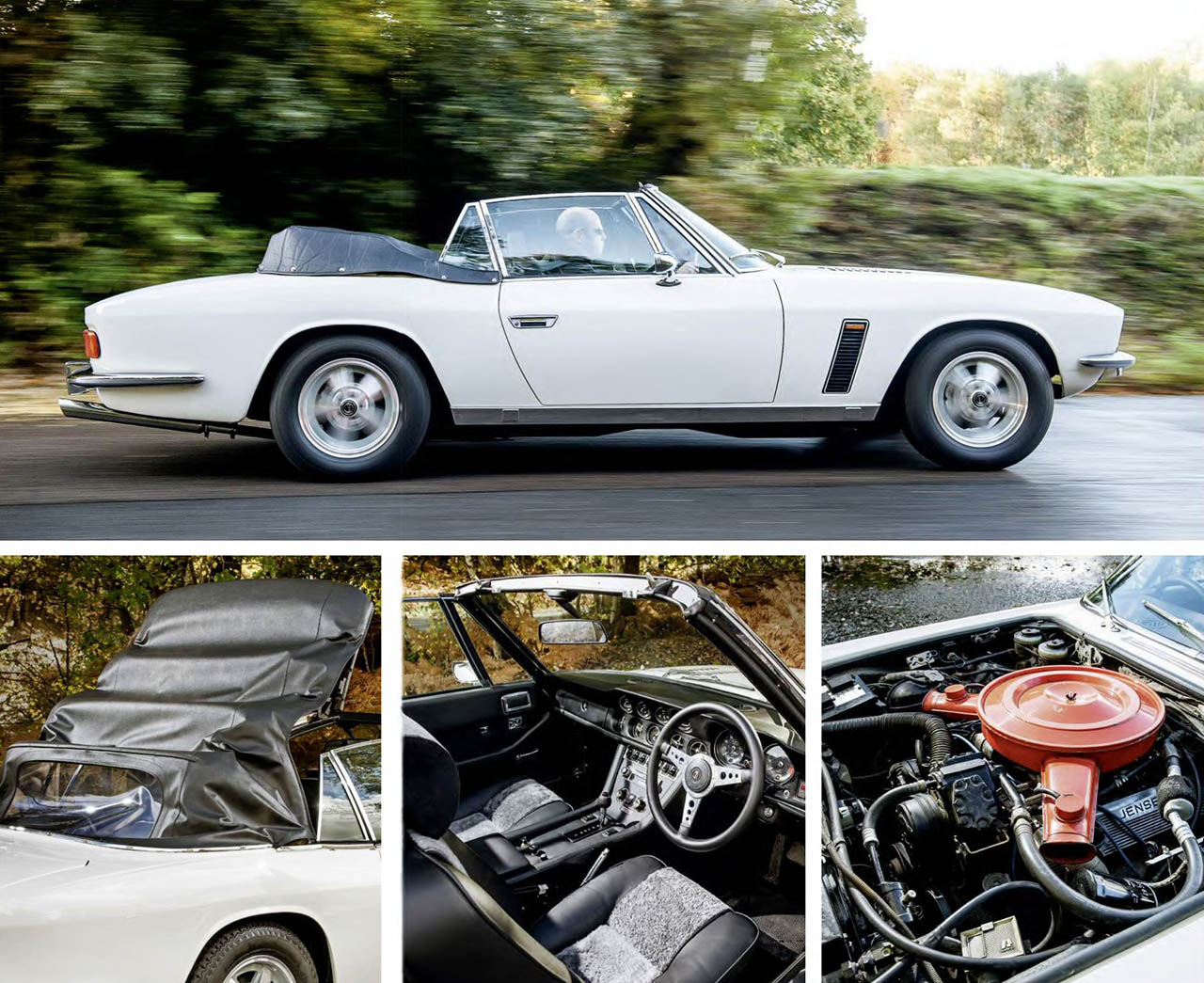
The Convertible has an appeal all of its own with the roof down. I’m that much more exposed to the burble of that 7.2-litre V8 than I have been in the fixed-roof cars and feel more at one with it as a result. A massive under-structure means that the Convertible is commendably stiff, so ride and roadholding, while not quite a match for the fixed-roof cars, are respectably together. Straight-line speed is much the same in the real world too.
Convertibles are rare, with just 509 made out of a total Interceptor population of more than 6000, and they’re highly sought-after, so values remain high. A top-notch example will be £100,000 or more but while solid cars can be found for half that, even a car in need of a lot of work can cost £35,000 or more.
INTERCEPTOR COUPÉ
The early Seventies was a difficult time for Britain’s specialist car makers. Trouble in the Middle East restricting oil supplies to the West in 1973 had already driven up fuel prices, then VAT raised petrol prices even further the following year. Almost overnight, society turned against big, thirsty cars, with even those who could afford them reluctant to be seen as irresponsible. Aston Martin went into receivership in 1974 and Jensen followed a year later. The company was crippled first by slow domestic sales, then the troublesome Jensen-Healey’s spiralling development costs – ironic, given it was introduced at the insistence of US car import magnate and Jensen’s biggest shareholder, Kjell Qvale.

Small-scale car production continued at West Bromwich to use up some of Jensen’s parts stock, and there was even a new model. Partbuilt Convertibles were dispatched to Robert Jankel’s Panther Westwinds company in Byfleet near Brooklands, where a fixed roof was added to produce the Interceptor Coupé. The roof was mostly glassfibre, but incorporated coloured glass panels behind the B-pillars and across the roof.
The glass roof makes the Coupé’s interior surprisingly light and airy, and the cabin is lifted further by the wood-faced dashboard that was adopted on all Interceptors in 1975. ‘Our’ green car may look rather battle-scarred, but it has an important place in Jensen history. It belonged to PR man Tony Good who went on became managing director, and strove to put together a financial deal to drag the company out of receivership. The usual version of the story is that the Labour government of the time had no interest in fast cars for fat cats and refused to lend Jensen the money it needed to get back on its feet, but Paul Lewis says that’s not entirely accurate. ‘They needed somewhere between £6 million and £10 million to continue and develop another model called the F-type,’ he says. ‘The government did in fact offer money, but Kjell Qvale turned it down.
‘Qvale was so dismayed at the strikes that hit Jensen in the early Seventies,’ Lewis says, ‘that he wanted to abandon car making altogether and slim the company down into a potentially more profitable engineering consultancy.’
‘Like all Interceptors, both Coupés drive with an ease and precision that belie their near two-tonne weight’
Jensen production finally ground to a halt in 1976 just as another new Interceptor variant was looming on the horizon. Sources vary on the number of Coupés that Jensen made in-house, but Adrian Phillips’ car is probably one of only three ever built and was completed after the company ended production. The American-spec double bumpers suggest it may originally have been left-hand drive.
Like all the Interceptors both Coupés drive with an ease and precision that belie their near two-tonne weight and the late V8 concedes horsepower only to the SP. The cabins feel very different without the glass hatchback – more big saloon than fastback GT – but the steel-roofed Jensen-built car is quieter at speed than the glassfibre-roofed Panther-converted car. Each, however, is a fine blend of luxury and performance that serves as a reminder of what might have been.
Jensen-built Coupés are so incredibly rare that they’re almost impossible to value. Certainly if one came up for sale it would be at the top end of the Interceptor values and well into six figures. The best of the 46 Panther-roofed Coupés built command similar values despite being slightly more plentiful, with good examples starting at around £50,000.
VERDICT
While it’s true that the Interceptor never had the highly strung handbuilt engines and true-blue heritage of its more exotic rivals, it has always deserved better than the second-class status it has endured for years. The Chrysler V8 may lack the cachet of an Italian V8 or V12, but all are potent, easy to maintain and upgrade and deliver an addictive thundering soundtrack when you put your foot down.
Better still, Kevin Beattie’s chassis work gave the Interceptor remarkable poise and balance for such a big and heavy car, though even the most ardent of Jensen devotees will readily admit that its natural talent lies in loping, long-distance cruising. Dynamics aside, though, it’s that timeless Touring shape that remains the Interceptor’s single biggest draw. Design tweaks may have come and gone over the years but the basic profile remained largely untouched even in the last-gasp S4 – for all of its troubles, Jensen clearly knew better than to tamper with its greatest asset. As the market finally wakes up to the Interceptor’s appeal, values have been on the rise for a while now, with good specialist parts back-up making restoration relatively straightforward for a handbuilt car. If a car that blends Italian style with British chassis finesse and tough American horsepower appeals, why wait any longer?
Thanks to: Jensen Owners’ Club (joc.org.uk) and in particular chairman Paul Lewis of PALE Classics (paleclassics.co.uk); Jason Lawrence at Rejen (rejen.co.uk) and Drive-My Jensen FF Club
JENSEN INTERCEPTOR/FF
Engine 6276cc-7212cc V8, ohv, Carter four-barrel carburettor (SP: three twin-choke Holley carburettors)
Power I-II: 276bhp @ 4600rpm. SP: 330bhp @ 4700rpm. / Early III: 305bhp @ 4800rpm. Late III: 280bhp @ 4800rpm
Torque I-II: 310lb ft @ 3400rpm. SP: 410lb ft @ 3200rpm. / Early III: 400lb ft @ 3200rpm. Late III: 380lb ft @ 3200rpm
Transmission Threespeed automatic, rear-wheel drive. / FF: three-speed automatic, four-wheel drive
Brakes Ventilated discs front and rear, servo assistance. / FF: Dunlop Maxaret anti-lock brakes
Steering Rack and pinion. Power assistance from 1968
Suspension Front: double wishbones, coil springs, anti-roll bar. / I: lever arm dampers, II-III: telescopic dampers. Rear: live axle, Panhard rod, leaf springs, telescopic dampers
Weight 1680-1973kg (3696-4340lb)
Performance Top speed: 129-143mph;
0-60mph: 6.9-8sec
Cost new £3743 (1966)-£9863 (1974)
Values now £25,000-£150,000
‘The basic profile remained largely untouched – Jensen clearly knew better than to tamper with its greatest asset’
Slightly wider wings with extra vents and longer wheelbase identify FF (right).
Steering ofers plenty of feel, but Interceptor is more GT cruiser than back-road sports car.
MARTIN RITCHIE 1969 FF
‘It’s number 100 of 320 made. It was in very good condition when I bought it apart from the door bottoms and one wheelarch beginning to go. I got Colin Holley at CH Autos to give it a bare metal respray in the original Jensen fawn – that was over seven years ago, and I’ve done probably 10,000 miles in it since then.
‘I had the engine fully rebuilt by Richard Appleyard when I discovered excessive crankshaft end-float and it seemed sensible to get the gearbox and transfer box refurbished and tidy up the engine bay while it was out. I’ve also had electronic ignition fitted.
‘To be honest, most of the things that have gone wrong have been fairly minor. The four-wheel drive system is pretty much bulletproof.
FF’s front passenger space is compromised by wider transmission tunnel and narrow seat.
JENSEN P66: THE INTERCEPTOR THAT NEVER WAS
Jensen started building big Healey bodies for BMC in 1952, but by the mid-Sixties the Austin-Healey 3000 was under threat from tightening safety and emissions regulations in the US, which was by far its biggest market. In 1964 Jensen explored the idea of a big Healey replacement using the CV8’s Chrysler V8 engine. The first of two prototypes, chassis number JM/ EXP/111, was a white convertible styled by Jensen’s body designer Eric Neale, who had also styled the 541 and CV8. Power came from a 6.2-litre Chrysler V8 driving through a Chrysler automatic gearbox. The car appeared on Jensen’s stand at the 1965 Earls Court London Motor Show wearing Interceptor badges, resurrecting the name of the GT Jensen built from 1950 to 1957.
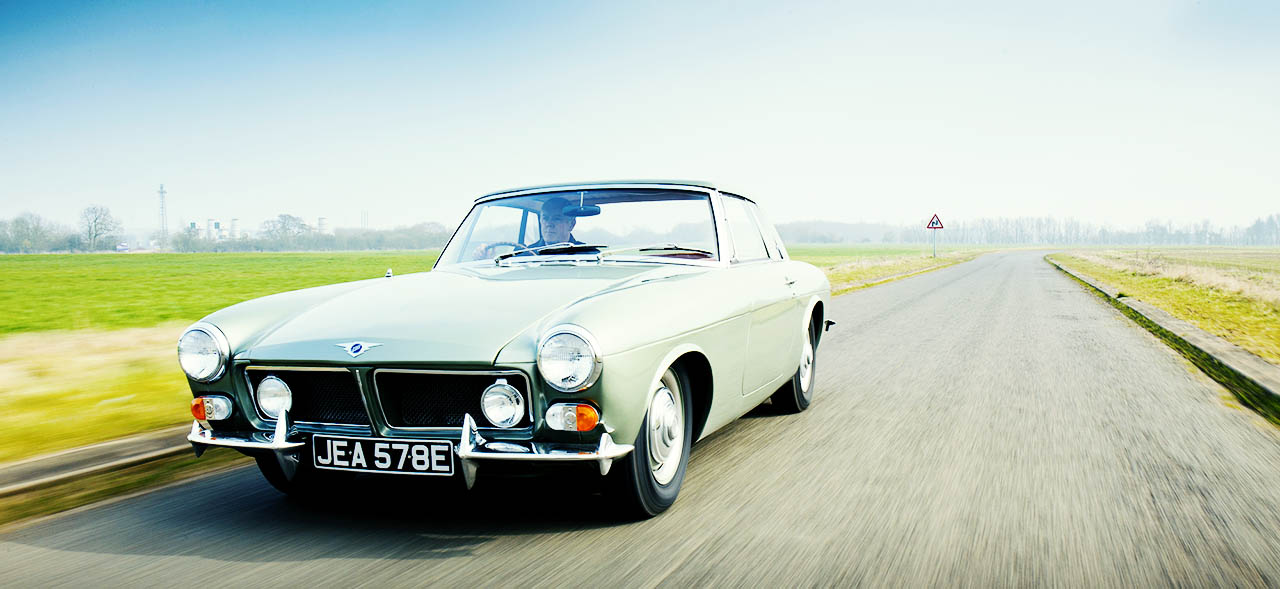
Soon after the show, work began on a second prototype, JM/ EXP/112, sporting a metallic green hardtop body and detail styling improvements. Again it had a 6.2-litre V8, though production cars were intended to use a 4.5-litre engine, this time driving through a four-speed manual gearbox. The cars were dubbed P66, probably in anticipation of their launch date. By now Jensen was under the control of the Norcros group, which decided to abandon the P66 and backed a plan by deputy chief engineer Kevin Beattie to approach Italian styling houses for what would eventually become the production Interceptor. Incensed at the way their plans had been shelved, Richard and Alan Jensen both left the company they founded. P66 designer Eric Neale made some detail improvements to Touring’s Interceptor design before full production began, but also left soon after.
The P66 convertible was broken up decades ago, but the hardtop survives to this day and has recently been restored.
The P66 was the Jensen brothers’ proposal for the new Interceptor. Classic Cars tested it in September 2002.
‘The high-compression Interceptor III seethes with intent at idle and the extra power more than offsets the extra weight’
EDDIE HARRAGAN 1970 INTERCEPTOR II
‘When I decided I wanted a Jensen Interceptor I read up on it and joined the Jensen Owners’ Club forum. My job involves building exhibition stands and my car is the 1970 Earls Court Motor Show car, so it’s a perfect fit. Inevitably it cost more than I really wanted to pay, but the motor show link meant that I simply had to buy it.
‘My advice to anyone thinking of buying one of these cars is that lower-quality examples are a false economy. The biggest job I’ve had to do is have the wheels rechromed by Motor Wheel Services in Slough. I’ve had some bits of bodywork done, and I plan to get the chrome around the windows refurbished over winter. I take it to Jensen specialist Richard Appleyard in Ilkeston. It’s been serviced twice in the time I’ve had it and has never missed a beat – it’s really reliable. It’s a great car to drive, too – you feel like the lord of the manor.’
Interceptor III’s high-compression 7.2-litre V8 is good for 385bhp.
Interceptor II and III’s handling was much improved by standard power-assisted steering and balljointed front suspension.
1969-on Interceptor II’s moulded dashboard was designed to meet US safety regulations.
The perfect company for a spirted crosscountry jaunt? Let us know at drive-my/en .
PAUL LEWIS 1972 INTERCEPTOR III
‘Rather bizarrely, this Interceptor III is our new kitchen. I already had an Interceptor III and my wife Lisa used to drive it. But if I was in the passenger seat on a country lane I’d constantly fret about it getting scratched by overhanging branches and so on.
‘We’d been talking about getting a new kitchen and Lisa said, ‘You know what? I’d rather have a Jensen of my own.’
This Interceptor III is her car. She drove it every day, and used to pick the kids up from school in it – it was the coolest car there.
‘This is one of the cars built in the six-month period when it changed over to the high-compression 7.2-litre V8 – it’s quite a fast car.
People think it’s a gas guzzler because it has a big engine, and that’s what’s held the prices down. But we’ve just done 1000 miles around Luxembourg and averaged 17mpg, so I’d say it’s comparable with other big GTs of its time.’
Side repeaters moved from the wing (MkII) to the air vent (MkIII).
SP proved that power can corrupt – it may be the most potent Interceptor, but it’s also the most temperamental.
SP: ‘SIX-PACK’ PERFORMANCE
When the Interceptor III was introduced in 1971 Jensen announced a high-performance SP model at the same time to take over from the now-discontinued FF as the range-topping car.
Everything on the Interceptor’s options list was standard on the SP, including a vinyl roof, eight-track stereo, air conditioning and Triplex Sundym tinted glass. The SP was distinguishable by its FF-style blue badges instead of the standard Interceptor’s red.
The most important difference was under the bonnet, however. SP stood for ‘Six-Pack’, which denoted the six carburettor throats provided by three dual-barrel Holley carburettors mounted on a bespoke iron intake manifold in the 7.2-litre engine’s vee. The centre carburettor operated normally, but the larger outer carbs were vacuum operated. Because the auxiliary carbs remained closed in gentle use touring fuel economy was relatively good – better than a standard Interceptor, in fact – but greater air flow, and therefore greater power, was available when the driver pushed the accelerator to the floor, with a claimed maximum of 385bhp.
The problem was that the SP’s throttle response was often unpredictable, because the secondary carburettor barrels often stayed open after the throttle was closed, and the SP subsequently gained a reputation for unreliability. High underbonnet temperatures – which were supposed to be alleviated by a full complement of bonnet louvres, though they didn’t achieve much in practice – caused rough running, so Jensen ofered a simpler fourbarrel carb as a service option.
As a result, the SP didn’t last long. Chrysler introduced the Six-Pack engine option into its own cars in 1969 but by the end of 1971 it was gone, a victim of increasingly stringent emissions regulations. Jensen’s own stock of SP engines lasted until 1973, by which time 232 SPs had been built. Today a good, sorted SP is worth in the region of £35,000.
MARK CAPEHORN 1974 CONVERTIBLE
‘I had a blue Jensen Interceptor III and always wanted my dream garage to contain a Convertible and an FF too. ‘FFs have now gone absolutely ballistic price-wise, but Jason at Rejen had this Convertible in stock and I bought it without telling my wife. Then when I told her it was her anniversary present I think she forgave me!
‘The bodywork was really good but it had been resprayed Oxford Blue. We wanted to go back to the original white so we treated it to a full bare metal respray.
‘The interior features genuine sheepskin inserts which were fitted at the Jensen factory – it’s an acquired taste but completely synonymous with the Seventies. It still needs detail work but Jason will do that during winter. If you think you’ve found a good one, get it inspected anyway. And get in now while you can – they’ve always been undervalued but I think people are starting to realise that now.’
‘A massive under-structure means the Convertible’s ride and roadholding are respectably together.
Convertible’s folded hood is bulky but at least you get to enjoy more V8 music.
Vast multi-layered hood folds electrically on to a tray behind the rear seat.
Sombre all-black cabin ofset by very Seventies factory sheepskin inserts.
Bright orange air cleaner housing brings a dash of colour to J-series engine.
JASON LAWRENCE 1976 INTERCEPTOR COUPÉ
‘My rare Pantherconverted car once belonged to Tony Good. He used to run a PR company called Good Relations, but ended up as managing director of Jensen towards the end of its life. ‘It’s one of only 27 right-handdrive coupés that Jensen ever made – Jensen took convertibles of the production line and sent them to Panther Westwinds to build the glassfibre roofs and fit the Jaguar XJ6 rear window.
‘It’s built to the final specification, with the wooden dashboard which was made standard from 1975. Jensen built these cars while the company was in receivership, so they didn’t make many.
‘I haven’t had to do much to it in the last 10 years or so. It’s pretty original, so the plan now is to carefully recommission it, rather than fully restore it – I really want to keep it as original as possible.’
ADRIAN PHILLIPS 1976 INTERCEPTOR COUPÉ
‘I sat in a black and tan Interceptor at a motor show when I was ten years old, and that’s where my love affair with them began. Jensen was just thinking about launching a factory-built coupé when it went bankrupt and I bought mine 11 years ago for my 50th birthday. It had just four miles on the clock, accrued mostly by driving to and from MoT test stations. I didn’t quite know what I’d bought at first. I took it to the first Jensen International Concours in 2004, and nobody had ever seen one before – it caused quite a stir. It coughed and spluttered all the way there and back because a fuel pipe had collapsed, but it cost about tuppence to replace.
‘I had a power steering hose go once in Derbyshire and came home on the back of an AA truck. The AA magazine even ran a photograph of it. It’s now got 7600 miles on it, all of them done by me. It doesn’t go out much – it’s too rare – but I get a lot of fun from it.’
S4: THE INTERCEPTOR’S FINAL FLING
After Jensen Motors went bankrupt in 1975 the official receiver formed two new companies: Jensen Special Products; and Jensen Parts and Service. The parts operation was based in the old Jensen service premises at Kelvin Way, West Bromwich and run by Ian Orford, who went on to buy the company in 1982.
Soon after he changed the company name to Jensen Cars and set about building new Interceptors. The first S4 was completed in the mid-1984 and was powered by a Seventies 7.2-litre V8, but subsequent production cars adopted a more modern 5.9-litre engine which was around 180lb lighter than the old big-block unit.
Some 500 detail changes were made to the car’s specification, most of which involved replacing obsolete parts with more modern components. Electrically adjustable leather-trimmed Recaro seats were standard and a steel air dam was added under the front bumper.
Jensen Cars charged around £45,000 for the S4 – twice the price of the contemporary Jaguar XJ-S, but about 10 per cent less than an Aston Martin V8 or Bristol Britannia.
It garnered good publicity following its starring role in a revival of the TV series The Saint in 1989, though it was actually an Interceptor III dressed up with S4 badges and an air dam to resemble one of the new cars.
Even so, production continued at a snail’s pace. Orford sold the company to design engineer Hugh Wainwright’s Unicorn Holdings with the hope of more regular production and greater investment in a new Interceptor S5, but the venture ended in failure in 1992. Jensen Cars had originally aimed to build 12 Interceptor S4s a year, but at the finish managed just 14 cars in nearly ten years.
Jensen-built steel roof Coupé design is better integrated than Panther’s glassfibre roof.
Wood-faced dashboard was fitted to all Interceptors from 1975 onwards.
Glass side and roof panels mark this Coupé as a Panther-converted car.
S4’s chin spoiler is made from proper lead-loaded steel.
Panther-converted Coupé’s Convertible origins are evident in curved rear threequarter haunches.
‘The basic profile remained largely untouched – Jensen clearly knew better than to tamper with its greatest asset’





